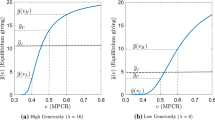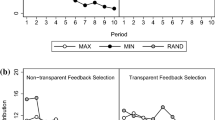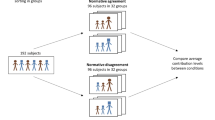Abstract
We investigate the effects of heterogeneity and incomplete information on aggregate contributions to a public good using the voluntary contribution mechanism. The non-linear laboratory environment has three-person groups as partners under varying conditions of information and communication. Bergstrom, Blum and Varian predict that increasing heterogeneity will have no effect on aggregate contributions in a no-communication environment. Ledyard conjectures a positive effect of incomplete information, a negative effect of heterogeneity, and a positive interaction of heterogeneity and incomplete information. We find that incomplete information has a small but significant negative effect. Heterogeneity has a positive effect on aggregate contributions, but its effects interact unexpectedly with communication. In a no-communication environment, heterogeneity in two dimensions (endowment and preferences) increases contributions substantially while heterogeneity in a single dimension (endowment or preferences) has little effect. In the communication environment we find the reverse. We also find a positive interaction between heterogeneity and incomplete information. Thus we reject the Bergstrom, Blume and Varian invariance result and provide mixed evidence on Ledyard's conjectures.
Similar content being viewed by others
References
Andreoni, J. (1993). “An Experimental Test of the Public Goods Crowding-Out Hypothesis.” American Economic Review. 83, 1317–1327.
Bagnoli, M. and McKee, M. (1991). “Voluntary Contribution Games: Efficient Private Provision of Public Goods.” Economic Inquiry. 29, 351–366.
Bardhan, P. (1993). “Symposium on Management of Local Commons.” The Journal of Economic Perspectives. 7, 87–92.
Bergstrom, T.C., Blume, L.E., and Varian, H.R. (1986). “On the Private Provision of Public Goods.” Journal of Public Economics. 29, 25–49.
Brookshire, D., Coursey, D., and Redington, D. (1993). “Special Interests and the Voluntary Provision of Public Goods.” Discussion Paper. Albuquerque: University of New Mexico.
Chan, K.S., Godby, R., Mestelman, S., and Muller, R.A. (1998). “Crowding Out Voluntary Contributions to Public Goods.” Working Paper 98-03, Hamilton, Canada: McMaster University.
Chan, K.S., Godby, R., Mestelman, S., and Muller, R.A. (1997). “Equity Theory and the Voluntary Provision of Public Goods.” Journal of Economic Behavior and Organization. 32, 349–364.
Chan, K.S., Mestelman, S., Moir, R., and Muller, R.A. (1996). “The Voluntary Provision of Public Goods Under Varying Income Distributions.” Canadian Journal of Economics. 29, 54–69.
Fisher, J., Isaac, R.M., Schatzberg, J., and Walker, J.M. (1994). “Heterogenous Demand for Public Goods: Behavior in the Voluntary Contributions Mechanism.” Public Choice. 85, 249–266.
Heckathorn, D.D. (1993). “Collective Action and Group Heterogeneity: Voluntary Provision Versus Selective Incentives.” American Sociological Review. 58, 329–350.
Hackett, S.C. (1992). “Heterogeneity and the Provision of Governance for Common-Pool Resources.” Journal of Theoretical Politics. 4, 325–342.
Hackett, S.C., Schlager, E., and Walker, J.M. (1994). “The Role of Communication in Resolving Commons Dilemmas: Experimental Evidence with Heterogeneous Appropriators.” Journal of Environmental Economics and Management. 27, 99–126.
Isaac, R.M. and Walker, J.M. (1988). “Communication and Free-Riding Behavior: The Voluntary Contribution Mechanism.” Economic Inquiry. 24, 585–608.
Kanbur, R. (1992). “Heterogeneity, Distribution, and Cooperation in Common Property Resource Management.” Policy Research Working Paper WPS 844, Washington, D.C.: World Bank.
Ledyard, J. (1995). “Public Goods: A Survey of Experimental Research.” In John Kagel and Alvin Roth (eds.), The Handbook of Experimental Economics. Princeton, NJ: Princeton University Press, pp. 111–194.
Marwell, G. and Ames, R. (1979). “Experiments on the Provision of Public Goods I: Resources, Interest, Group Size, and the Free-Rider Problem.” American Journal of Sociology. 84, 1335–1360.
Marwell, G. and Ames, R. (1980). “Experiments on the Provision of Public Goods II: Provision Points, Stakes, Experience and the Free-Rider Problem.” American Journal of Sociology. 85, 926–937.
Marwell, G., Oliver, P.E., and Prahl, R. (1988). “Social Networks and Collective Actions: A Theory of the Critical Mass III.” American Journal of Sociology. 94, 502–534.
Moir, R. (1996). The Analysis of Cooperation in Collective Action Games: Experimental Evidence. Ph.D. Thesis. Hamilton, Canada: McMaster University.
Moir, R. (1998). “A Monte Carlo Analysis of the Fisher Randomization Technique: Reviving Randomization for Experimental Economists.” Experimental Economics. 1, 87–100.
Muller, R.A. and Vickers, M. (1996). “Communication in a Common Pool Resource Environment with Probabilistic Destruction.” Working Paper 96-06, Hamilton, Canada: McMaster University.
Oliver, P.E., Marwell, G., and Teixeira, R. (1985). “A Theory of the Critical Mass I: Interdependence, Group Heterogeneity, and the Production of Collective Action.” American Journal of Sociology. 91, 522–556.
Olson, M. (1983). “The Political Economy of Comparative Growth Rates.” In Dennis Mueller (ed.), The Political Economy of Growth. New Haven: Yale University Press, pp. 7–52.
Ostrom, E. (1992). Crafting Institutions for Self-Governing Irrigation Systems. San Francisco, California: ICS Press.
Rapoport, A. and Suleiman, R. (1993). “Incremental Contribution in Step-Level Public Goods Games with Asymmetric Players.” Organizational Behavior and Human Decision Processes. 55, 171–194.
Walker, J.M., Gardner, R., and Ostrom, E. (1990). “Rent Dissipation in Limited Access Common-Pool Resource Environments: Experimental Evidence.” Journal of Environmental Economics and Management. 19, 203–211.
Author information
Authors and Affiliations
Corresponding author
Rights and permissions
About this article
Cite this article
Chan, K.S., Mestelman, S., Moir, R. et al. Heterogeneity and the Voluntary Provision of Public Goods. Experimental Economics 2, 5–30 (1999). https://doi.org/10.1023/A:1009984414401
Issue Date:
DOI: https://doi.org/10.1023/A:1009984414401




